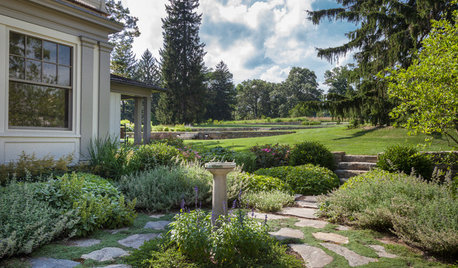How to restore lawn come spring?
stein54
9 years ago
Related Stories

TRADITIONAL HOMESHouzz Tour: Connecticut Farm Restored for Generations to Come
A man renovates his extended family’s stately farmhouse and land. Sustainable practices are used in gardens, wetlands and recreation areas
Full Story
LANDSCAPE DESIGNExplore a Magical Restored English Garden
History comes alive in the gardens of a Rochester townhouse, filled with sculptural yew, a topiary parterre and an archway-draped pond
Full Story
GARDENING GUIDESHow to Fix Bare and Yellow Lawn Spots
Restore your turf’s good looks by reseeding unsightly patches
Full Story
HOUZZ TOURSRare Modernist Home Uncovered in Palm Springs
A custom home by modernist William Krisel gets restored and updated
Full Story
BEFORE AND AFTERSSee 6 Yards Transformed by Losing Their Lawns
Wondering whether a turf lawn is the best use of your outdoor space? These homeowners did, and they found creative alternatives
Full Story
GARDENING AND LANDSCAPINGSpring Party Primer: 20 Ideas for Fabulous Fetes
Roll out the green carpet. On a lawn or in your living room, your spring party will be a hit with these tips and ideas
Full Story
EVENTSSee Frank Lloyd Wright Treasures and More at This Spring House Walk
Celebrate the birth of modern architecture with a spring tour of Chicago-area Frank Lloyd Wright homes this May
Full Story
GARDENING GUIDESWhat Are Your Spring Gardening Plans?
Tearing out the lawn? Planting edibles? Starting from scratch? Tell us what you plan to change in your garden this year
Full Story
EARTH DAYThe Case for Losing the Traditional Lawn
Work less, help the environment and foster connections by just saying no to typical turf
Full Story
LANDSCAPE DESIGN15 Great Ideas for a Lawn-Free Yard
End the turf war for good with hardscaping, native grasses and ground covers that save water and are easier to maintain
Full StoryMore Discussions







maplerbirch
User
Related Professionals
Allentown Landscape Architects & Landscape Designers · Ashland Landscape Architects & Landscape Designers · Simi Valley Landscape Architects & Landscape Designers · Allentown Landscape Contractors · Wakefield Landscape Contractors · Athens Landscape Contractors · Berkeley Heights Landscape Contractors · Farmington Landscape Contractors · Quincy Landscape Contractors · Webster Groves Landscape Contractors · West Chicago Landscape Contractors · Maplewood Landscape Contractors · Palos Heights Landscape Contractors · Claremont Swimming Pool Builders · Manassas Swimming Pool BuildersBoatDrinksq5
morpheuspa (6B/7A, E. PA)
dchall_san_antonio
maplerbirch
morpheuspa (6B/7A, E. PA)